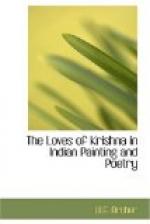About 1400, palm-leaf was superseded by paper and from then onwards manuscripts were given slightly larger pages. Owing partly to their association with the same religious order and partly to their constant duplication, Jain manuscripts had early conformed to a certain rigid type. The painting was marked by lean and wiry outlines, brilliant red and blue and above all by an air of savage ferocity expressed through the idiom of faces shown three-quarter view with the farther eye detached and projecting into space. This style was exercised almost exclusively on Jain subjects and in the year 1400 it was the main style of painting in Western India and Raj as than.
During the fifteenth century, this exclusive character gradually weakened. There arose the idea that besides Jain scriptures, secular poetry might also be illustrated and along with the growing devotion to Krishna as God came the demand for illustrated versions of Krishna texts. The three texts we have just mentioned are due to this tendency. All three are illustrated in the prevailing Jain style with its spiky angular idioms and all three have the same somewhat sinister air of barbarous frenzy. At the same time, all disclose a partial loosening of the rigid wiry convention, a more boisterous rhythm and a slightly softer treatment of trees and animals; and, although no very close correlation is possible, the theme itself may well have helped to precipitate these important changes.
Between 1450 and 1575, Western Indian painting continued to focus on Jain themes, adulterated to only a very slight extent by subjects drawn from poetry. It is possible that the Krishna story was also illustrated, but no examples have survived; and it is not until the very end of the sixteenth century that the Krishna theme again appears in painting and then in two distinct forms. The first is represented by a group of three manuscripts—two of them dated respectively 1598[68] and 1610[69] and consisting of the tenth book of the Bhagavata Purana, the third being




